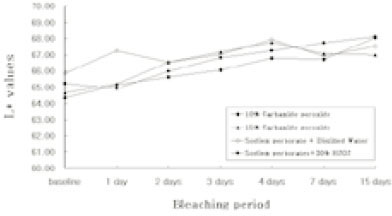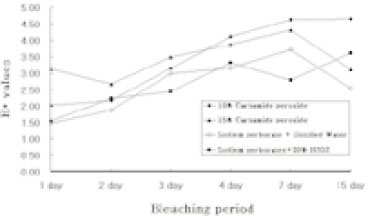J Korean Acad Conserv Dent.
2002 Jul;27(4):441-447. 10.5395/JKACD.2002.27.4.441.
Bleaching effect of carbamide peroxide gel on discolored nonvital teeth
- Affiliations
-
- 1Department of Conservative Dentistry, College of Dentistry, Korea.
- 2Department of Dental Materials, Dental Science Research Institute, Chonnam National University, Korea.
- 3Department of Dentistry, College of Medicine, Seonam University, Korea.
- KMID: 1987300
- DOI: http://doi.org/10.5395/JKACD.2002.27.4.441
Abstract
- The bleaching of discolored nonvital teeth is conservative treatment that satisfy the cosmetic desire. The most common method for this treatment, walking bleaching, is using 30% hydrogen peroxide and sodium perborate. Many alternatives are suggested for preventing the external cervical root resorption that is the common complication of the nonvital teeth bleaching with 30% hydrogen peroxide. The same extent of oxidation reactions as that resulted by the bleaching with the application of 30% hydrogen peroxide and sodium perborate can also be acquired more safely by materials that contain 10% carbamide peroxide, used primarily for the bleaching of vital teeth. Therefore, this study was performed to evaluate the efficacy of 10% and 15% carbamide peroxide bleaching gel in nonvatal teeth bleaching. The internal bleaching of intentionally discolored teeth was performed in vitro with 10% carbamide peroxide (Group 1), 15% carbamide peroxide (Group 2), mixture of distilled water and sodium perborate (Group 3), and mixture of 30% hydrogen peroxide and sodium perborate (Group 4). The bleaching materials were refreshed following 3, 6, 9 and 12 days. To evaluate the bleaching effect, the color change of the crowns was measured at 1, 2, 3, 4, 7 and 15 days of bleaching using the colorimeter. The results were as follows : 1. L* and DeltaE* values were increased with time in all bleaching agents(p<0.01). 2. There was no significant difference in L* and DeltaE* value among bleaching agents. 3. DeltaE* value higher than 3 was shown after 3 days of bleaching with 10% carbamide peroxide gel, 1 day with 15% carbamide peroxide gel, 4 days with mixture sodium perborate and distilled water and 4 days with mixture sodium perborate and 30% hydrogen peroxide, respectively. These results revealed that the use of 10% and 15% carbamide peroxide bleaching gel in non-vital teeth bleaching is as effective as mixture of distilled water and sodium perborate and mixture of 30% hydrogen peroxide and sodium perborate. Accordingly, carbamide peroxide could be used clinically to bleach discolored non-vital teeth.
MeSH Terms
Figure
Reference
-
1. Grossman LI. Endodontic Practice. 1978. ed. 2. Philadelphia: Lea & Febiger;322–323.2. Nutting EB, Poe GS. A new combination of bleaching teeth. J South Calif Dent Assoc. 1963. 31:289–291.3. Latcham NL. Postbleaching cervical resorption. J Endod. 1986. 12:262–264.
Article4. Goon WWY, Cohen S, Borer RF. External cervical root resorption following bleaching. J Endod. 1986. 12:414–418.
Article5. Friedman S, Rotstein I, Libfeld H, Stabholz A, Heling I. Incidence of external root resorption and esthetic results in 58 bleached pulpless teeth. Endod Dent Traumatol. 1988. 4:23–26.
Article6. Chivian N. Cohen S, Burns RC, editors. Root resorption. Pathways of the pulp. 1987. 4th ed. St. Louis: C.V Mosby;534–538.7. Holmstrup G, Palm AM, Lambjerg-Hansen H. Bleaching of discolored root-filled teeth. Endod Dent Traumatol. 1988. 4:197–201.8. Spasser HF. A simple bleaching technique using sodium perborate. NY State Dent J. 1961. 27:332–334.9. Rotstein I, Alkind M, Mor C, Tarabeach A, Friedman S. In vitro efficacy of sodium perborate preparation used for intracoronal bleaching of discolored non-vital teeth. Endod Dent Traumatol. 1991. 7:177–180.10. Rotstein I, Mor C, Friedman S. Prognosis of intracoronal bleaching with sodium perborate preparation in vitro: 1-year study. J Endod. 1993. 19:10–12.
Article11. Ho S, Goering AC. An in vitro comparison of different bleaching agents in the discolored teeth. J Endod. 1989. 15:106–111.
Article12. Costas FL, Wong M. Intracoronal isolating barriers : Effect of location root leakage and effectiveness of bleaching agents. J Endod. 1991. 17:365–368.
Article13. Rotstein I, Zyskind D, Lewinstein I, Baumberger N. Effect of different protective base materials on hydrogen peroxide leakage during intracoronal bleaching in vitro. J Endod. 1992. 18:114–117.
Article14. McInerney ST, Zillich R. Evaluation of intracoronal sealing ability of three materials. J Endod. 1992. 18:376–378.15. Smith JJ, Cunningham CJ, Montgomery S. Cervical canal leakage after internal bleaching procedures. J Endod. 1992. 18:476–481.
Article16. Warren MA, Wong M, Ingram TA III. An in vitro comparison of bleaching agents on the crowns and root of discolored teeth. J Endod. 1990. 16:463–467.
Article17. Baratieri LN, Ritter AV, Monterio S Jr, Caldera de Andrada MA, Cardoso Vieira LC. Nonvital tooth bleaching: Guidelines for the clinician. Quintessence Int. 1995. 26:597–608.18. Rotstein I. Role of catalase in the elimination of residual hydrogen peroxide following tooth bleaching. J Endod. 1993. 19:567–569.
Article19. Haywood VB, Heymann HO. Nightguard vital bleaching. Quintessence Int. 1989. 20:173–176.20. Goldstein RE, Garbar DA. Complete dental bleaching. 1995. Hongkong Quintessence Publishing Co;25–33. 71–100.21. Strassler HE. Insights and innovations: at-home bleaching. J Esthet Dent. 1989. 1:176.22. Haywood VB, Heymann HO. Response of normal and tetracycline-stained teeth with pulp-size variation to nightguard vital bleaching. J Esthet Dent. 1994. 6:109–114.
Article23. Haywood VB. History, safty, and effectiveness of current bleaching techniques and applications of nightguard vital bleaching technique. Quintessence Int. 1992. 23:471–488.24. Settembrini L, Gultz J, Kaim J, Scherer W. A technique for bleaching nonvital teeth : inside/outside bleaching. J Am Dent Assoc. 1997. 128:1283–1284.25. Liebenberg WH. Intracoronal lightening of discolored pulpless teeth : A modified walking bleaching technique. Quintessence Int. 1997. 28:771–777.26. Carillo A, Arrendondo Trevino MV, Haywood VB. Simultaneous bleaching of vital teeth and open-chamber nonvital tooth with 10% carbamide peroxide. Quintessence Int. 1998. 29:643–648.27. Vachon C, Vanek P, Friedman S. Internal bleaching with 10% carbamide peroxide in vitro. Pract Periodontics Aesthet Dent. 1998. 10:1145–1154.28. Freccia WF, Peters DD. A technique for staining extracted teeth : a research and teaching aid for bleaching. J Endod. 1982. 8:67–69.
Article29. Fasanaro T. Bleaching teeth: history, chemicals, and methods used for common tooth discolorations. J Esthet Dent. 1992. 4:71–78.
Article30. Kleber CJ, Putt MS, Nelson BJ. In vitro tooth whitening by a sodium bicarbonate/peroxide dentifrice. J Clin Dent. 1998. 9:16–21.31. Bosch JJ, Coops JC. Tooth color and reflectance as related to light scattering and enamel hardness. J Dent Res. 1995. 74:374–380.
Article32. Lenhard M. Assessing tooth color change after repeated bleaching in vitro with a ten percent carbamide peroxide gel. J Am Dent Assoc. 1996. 127:1618–1624.33. Kuehni FG, Marcus RT. An experiment in visual scanning of small color difference. Color Res Appl. 1979. 4:83–91.34. Ruyter IE, Nilnu K, Moller B. Color stability of dental composite resin materials for crown and bridge veneers. Dent Mater. 1987. 3:246–251.
Article35. Gross MD, Moser JB. A colorimetric study of coffee and tea staining of four composite resins. J Oral Rehabil. 1977. 4:311–322.
Article36. Seghi RR, Hewlett ER, Kim J. Visual and instrumental colorimetric assessments of small color differences on translucent dental porcelain. J Dent Res. 1989. 68:1760–1764.
Article
- Full Text Links
- Actions
-
Cited
- CITED
-
- Close
- Share
- Similar articles
-
- Can carbamide peroxide be as effective as hydrogen peroxide for in-office tooth bleaching and cause less sensitivity? A systematic review
- Effect of vital tooth bleaching agent on dentin bonding
- The effect of various commercially available bleaching agents on the microshear bond strength of composite resin to enamel
- A clinical evaluation of safety of an office bleaching gel containing 30% hydrogen peroxide
- A clinical evaluation of efficacy of an office bleaching gel containing 30% hydrogen peroxide



